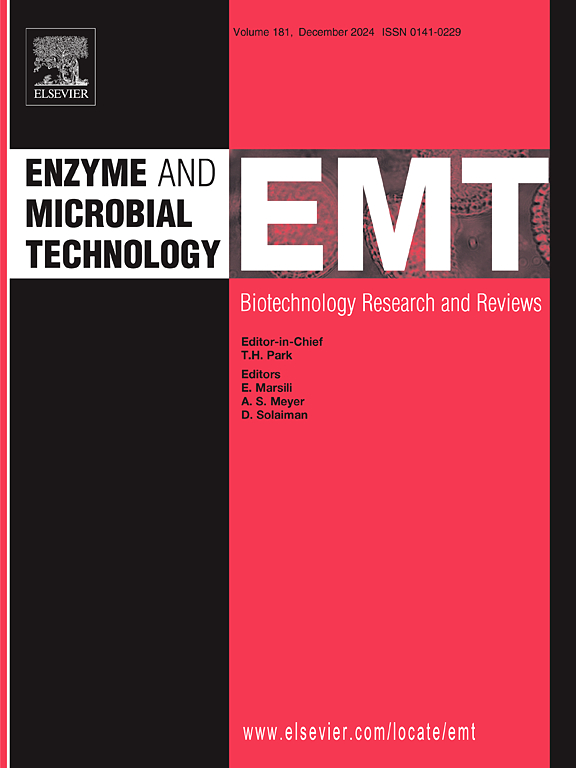An integrated approach based on sequential fractionation and specific enzymatic saccharification of green algae Ulva sp. biomass
IF 3.7
3区 生物学
Q2 BIOTECHNOLOGY & APPLIED MICROBIOLOGY
引用次数: 0
Abstract
Marine green algae of the genus Ulva are abundant worldwide. In the case of eutrophication, they can be stranded in large quantities, thereby causing ecological and economic problems. Compared to other macroalgae, this biomass remains underexploited on an industrial scale. Thus, the aim of this study was to develop an integrated downstream process applicable to the biomass of the green algae Ulva sp., allowing a major sequential recovery of high-added-value fractions corresponding to pigments, ulvan, alkali-soluble hemicelluloses, and cellulose. Indeed, the proposed concept using cascade extractions enable to produce 0.64 ± 0.16 % of pigments rich in chlorophylls and caroténoids, 28 ± 0.8 % of ulvan, 5 ± 0.3 % of alkali-soluble hemicelluloses and 10 ± 0.4 % of cellulose based on initial dry weight. Characterization of the extracted polysaccharides and verification of their purity were confirmed using FTIR and monosaccharide composition analyses. To better evaluate the biodegradability and the success of the extraction procedure, enzymatic saccharification was applied at the end of the cascade using the cellulose fraction as the substrate. In parallel, saccharification of the total algal biomass was also carried out under the same conditions. Results showed a significant improvement in conversion yields from 74.6 ± 0.85 % to 84 ± 0.7 % showing that Ulva’s cellulose fraction can be a promising candidate for biofuels production. This study presents a sustainable biorefinery approach that allows almost complete fractionation and bioconversion of green macroalgae, and integrates the concept of a circular bio-economy.
绿藻Ulva sp.生物质顺序分选与特定酶糖化的综合研究
藻属的海洋绿藻在世界各地都很丰富。在富营养化的情况下,它们可能大量搁浅,从而造成生态和经济问题。与其他大型藻类相比,这种生物量在工业规模上仍未得到充分利用。因此,本研究的目的是开发一种适用于绿藻Ulva sp.生物量的综合下游工艺,允许大量顺序回收高附加值组分,如色素、ulvan、碱溶性半纤维素和纤维素。事实上,提出概念使用级联的抽取,使生产0.64 ±0.16 %富含叶绿素和类胡萝卜素的色素,28 ±0.8 ulvan %, 5 ±0.3 %的碱溶纤维素和10 ±0.4 %基于初始干重的纤维素。利用红外光谱(FTIR)和单糖组成分析对提取的多糖进行了表征和纯度鉴定。为了更好地评估生物降解性和提取过程的成功,在级联的最后使用纤维素部分作为底物进行酶解糖化。同时,在相同的条件下也进行了总藻类生物量的糖化。结果表明,转化率从74.6 ± 0.85 %显著提高到84 ± 0.7 %,表明Ulva的纤维素组分可以成为生物燃料生产的有希望的候选物。本研究提出了一种可持续的生物炼制方法,该方法允许绿色大型藻类几乎完全分离和生物转化,并整合了循环生物经济的概念。
本文章由计算机程序翻译,如有差异,请以英文原文为准。
求助全文
约1分钟内获得全文
求助全文
来源期刊

Enzyme and Microbial Technology
生物-生物工程与应用微生物
CiteScore
7.60
自引率
5.90%
发文量
142
审稿时长
38 days
期刊介绍:
Enzyme and Microbial Technology is an international, peer-reviewed journal publishing original research and reviews, of biotechnological significance and novelty, on basic and applied aspects of the science and technology of processes involving the use of enzymes, micro-organisms, animal cells and plant cells.
We especially encourage submissions on:
Biocatalysis and the use of Directed Evolution in Synthetic Biology and Biotechnology
Biotechnological Production of New Bioactive Molecules, Biomaterials, Biopharmaceuticals, and Biofuels
New Imaging Techniques and Biosensors, especially as applicable to Healthcare and Systems Biology
New Biotechnological Approaches in Genomics, Proteomics and Metabolomics
Metabolic Engineering, Biomolecular Engineering and Nanobiotechnology
Manuscripts which report isolation, purification, immobilization or utilization of organisms or enzymes which are already well-described in the literature are not suitable for publication in EMT, unless their primary purpose is to report significant new findings or approaches which are of broad biotechnological importance. Similarly, manuscripts which report optimization studies on well-established processes are inappropriate. EMT does not accept papers dealing with mathematical modeling unless they report significant, new experimental data.
 求助内容:
求助内容: 应助结果提醒方式:
应助结果提醒方式:


